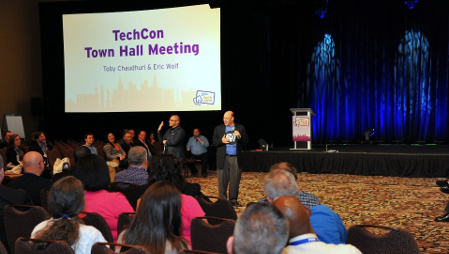PBS TechCon Blends the Best of Broadcast and Technology
As a broadcast veteran, I have the advantage of looking back to look forward. In this new column, I hope to bring some of my “rear-view mirror” insight to help us best navigate the challenging and turbulent times for our industry.
In recent years, one of the issues that has been a source of confusion and frustration is the separate naming of what have been called ”broadcast,” “digital” and “technology” businesses and services. We need to revisit this issue because the boxes hinder our industry. Let’s start with some definitions.

“Broadcast” has become narrowly defined to encompass only linear distribution and consumption. “Digital” often is the moniker for everything else, encompassing online, broadband, OTT and mobile distribution and consumption. Silicon Valley companies have been narrowly tagged with the “Technology” industry name.
The narrow and divisive use of these names is problematic because it implies that somehow these sectors are distinctly different and non-overlapping. The implication is that the “broadcast” industry is neither digital nor a driver of technology
Nothing could be further from the truth. In fact, the broadcast industry has always been both a digital and an advanced technology pioneer. Netflix, Amazon and Google are clearly in the television/broadcast business today, and their presence and impact continue to grow at a dramatic pace.
PBS TECHCON
I am happy to say that at the 2016 PBS Technology Conference there was finally a refreshing blurring and blending of these naming silos. This annual conference has been held just prior to the NAB Show in Las Vegas for nearly four decades, and draws more than 500 attendees.
The agenda at the PBS Technology Conference this year combined what in the past has been separate sessions (and even separate conferences) for broadcast, digital and technology cohorts. The conference blended both topics and attendees in a way that I had not seen previously. From the opening session, a keynote by Robert Tercek, author of “Vaporized: Solid Strategies for Success in a Dematerialized World,” to the closing “Town Hall” session that encompassed broadcast, online, interactive, over-the-top and new technologies, the conference shed the historical separation that I had seen so many times in years past. Tercek shared his perspective that broadcast is not dying, despite headlines to the contrary; instead, it is in the process of reinvention, leveraging the dynamics of digital transformation, innovation and disruption. He went on to show how multiple vectors of digital change are rewriting the rules of TV and other industries.
Throughout nearly 70 sessions over three days, discussions blended broadcast, digital and technology. We learned how the PBS News Hour innovates on digital platforms to complement their nightly broadcast, and provides stations tools to do the same in their local markets. We saw stations who have re-imagined media operations to approach production and delivery across all platforms using a holistic model. PBS Digital Studios, a multichannel YouTube network, shared their successes with more than seven million subscribers and 450 million views across 15 active online shows. These are high-quality shows made specifically for online audiences and delivery that are tightly aligned with the PBS brand. Of course, there were also several deeply technical sessions, covering such topics as HDR, UHD/4K production and workflows, IP routing, disaster recovery, and ATSC 3.0.
WELL-ROUNDED
The result? A richer dialog, more collaboration and increased strategic thinking. Public television organizations seem to have figured out that they are in the “media” business where a strategic and blended view of creation, distribution and monetization of content has led to better efficiencies, new revenue models and vastly improved consumer experiences and relationships – all based around a single coherent view of broadcast, digital and advanced technology.
But what does this blending of technology mean for your organization—regardless of whether you consider yourself to be ”broadcast,” “digital,” “technology” or some combination of those? What’s the impact on how you will go to market? Your customers? Or better yet, your people? Through this column, I’m going to take advantage of my perspective—looking back to look forward—to explore what the future might just look like.
John McCoskey is Industry Lead Executive - Communications, Media & Technology at Eagle Hill Consulting in Arlington, VA. He can be reached atjmccoskey@eaglehillconsulting.com.
Get the TV Tech Newsletter
The professional video industry's #1 source for news, trends and product and tech information. Sign up below.
